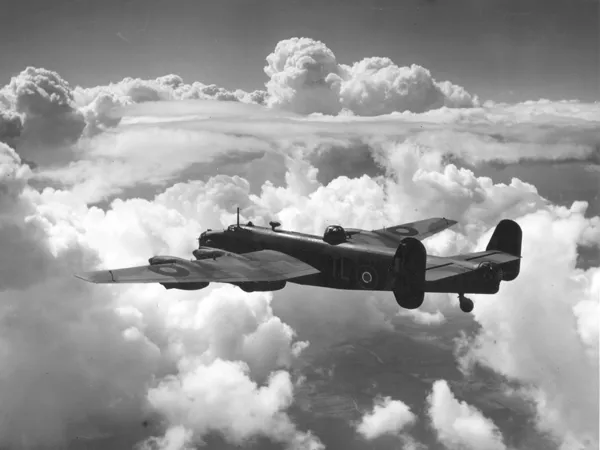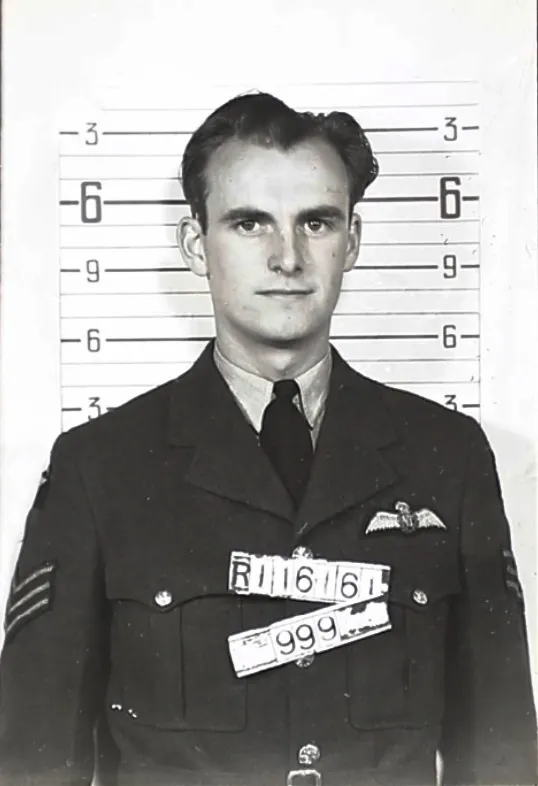On 1943-04-18, S/L A. Ross Dawson, a Technical Officer with 1659 HCU at Topcliffe, wrote in his diary:
"Well we ran into more trouble today. S/L Hill, our 22 year old flight commander of B flight crashed this morning in L for London, our oldest kite, only 25 hours off its second major and everyone was killed, 8 of them. I had become great friends with Howie Hill and it really shook me to think of him going like that. He was always lively& ready for anything. He had gone his whole tour of ops, won the DFM & then ended like that. Only a couple of weeks ago I remember talking about what we were going to do after the war & he was saying he didn't really have much to go back to." Ross was asked if he would assist with the investigation but he declined: "I don't mind so much if it's fellows I don't know but when it comes to my best friends, I'd rather leave it to someone else." Ross does, however, provide a quite detailed description of what occurred "They took off at 9;45 & crashed just south of York at 10:12. He was suppose to be doing two-engine exercises with his pupil & crew but from eye-witness accounts, all four engines were going nicely when it happened. He was about feet just south of York when suddenly one elevator started to flap up & down as if the linkage controls had broken. Then, obviously out of control, the plane did two complete rolls & and dived straight down while one elevator came off and landed about 150 yds away from the debris. It ploughed straight into the ground & fortunately the boys would never know a thing after that first smash. There were three holes in the ground, one for each of the outboard engines & one large one for the fuselage and the two inner engines _ these engines were down almost out of sight in the earth so they really hit hard. The fuselage had folded up like an accordion & then when it caught fire it just melted all own into a molten mass at the bottom of the hole. . . The investigation showed that one of the torque brackets on the main elevator must have failed causing the plane to go out of control." He concludes with "that's just the way it goes & tomorrow it will be more or less forgotten & no one will speak of it again if they can help it. That's the way it has to be in war time."
Click on CASPIR logo to go to the entire CASPIR system.

Use the panel to:
- select Optional Sections
- Remove Page Breaks, that is, return to the non-print formatted document.
- Click on the ⇩ to go directly to that section.
Davies, Brian Tristram (Flying Officer)
Killed in Flying Accident 1943-April-18


Birth Date: 1922 (age 21)
RAFVR
1659 (OT) HCU- Heavy Conversion Unit
Topcliffe
| Marshal | |
| Air Chief Marshal | A/C/M |
| Air Marshal | A/M |
| Air Vice Marshal | A/V/M |
| Air Commodore | A/C |
| Group Captain | G/C |
| Wing Commander | W/C |
| Squadron Leader | S/L |
| Flight Lieutenant | F/L |
| Flying Officer | F/O |
| Pilot Officer | P/O |
| Warrant Officer 1st Class | WO1 |
| Warrant Officer 2nd Class | WO2 |
| Flight Sergeant | FS |
| Sergeant | SGT |
| Corporal | CPL |
| Senior Aircraftman | SAC |
| Leading Aircraftman | LAC |
| Aircraftman 1st Class | AC1 |
| Aircraftman 2nd Class | AC2 |
Pilot
125498
Halifax B.Mk.II R9448Operational 1943-April-18 to 1943-April-18
Crashed at Crockey Hill, Escrick, York during two engine training 18.4.43 Unit 35/405 Conversion Flight/ 1659 Heavy Conversion Unit
 Library and Archives Canada Service Files (may not exist)
Library and Archives Canada Service Files (may not exist)
Crew on Halifax B.Mk.II R9448
Handley Page Halifax

The Handley Page Halifax is a British Royal Air Force (RAF) four-engined heavy bomber of the Second World War. It was developed by Handley Page to the same specification as the contemporary twin-engine Avro Manchester.
The Halifax has its origins in the twin-engine HP56 proposal of the late 1930s, produced in response to the British Air Ministry's Specification P.13/36 for a capable medium bomber for "world-wide use." The HP56 was ordered as a backup to the Avro 679, both aircraft being designed to use the underperforming Rolls-Royce Vulture engine. The Handley Page design was altered at the Ministry to a four-engine arrangement powered by the Rolls-Royce Merlin engine; the rival Avro 679 was produced as the twin-engine Avro Manchester which, while regarded as unsuccessful mainly due to the Vulture engine, was a direct predecessor of the famed Avro Lancaster. Both the Lancaster and the Halifax would emerge as capable four-engined strategic bombers, thousands of which would be built and operated by the RAF and several other services during the War.
On 25 October 1939, the Halifax performed its maiden flight, and it entered service with the RAF on 13 November 1940. It quickly became a major component of Bomber Command, performing routine strategic bombing missions against the Axis Powers, many of them at night. Arthur Harris, the Air Officer Commanding-in-Chief of Bomber Command, described the Halifax as inferior to the rival Lancaster (in part due to its smaller payload) though this opinion was not shared by many of the crews that flew it, particularly for the MkIII variant. Nevertheless, production of the Halifax continued until April 1945. During their service with Bomber Command, Halifaxes flew a total of 82,773 operations and dropped 224,207 tons of bombs, while 1,833 aircraft were lost. The Halifax was also flown in large numbers by other Allied and Commonwealth nations, such as the Royal Canadian Air Force (RCAF), Royal Australian Air Force (RAAF), Free French Air Force and Polish forces. Wikipedia
 National Air Force Museum of Canada
National Air Force Museum of Canada
CASPIR Aircraft Groups:
RCAF On Strength (5), RCAF 6 Group (1596), RCAF 400 Squadron (1443), Canadian Aircraft Losses (1562), Canadian Museum(2)Halifax B.Mk.II R9448
PC — Ctrl-F
Mac — ⌘-F
Mobile —







 Halifax Heavy Bomber WWII
Halifax Heavy Bomber WWII Harold A Skaarup Web Page
Harold A Skaarup Web Page Wikipedia Halifax Bomber
Wikipedia Halifax Bomber